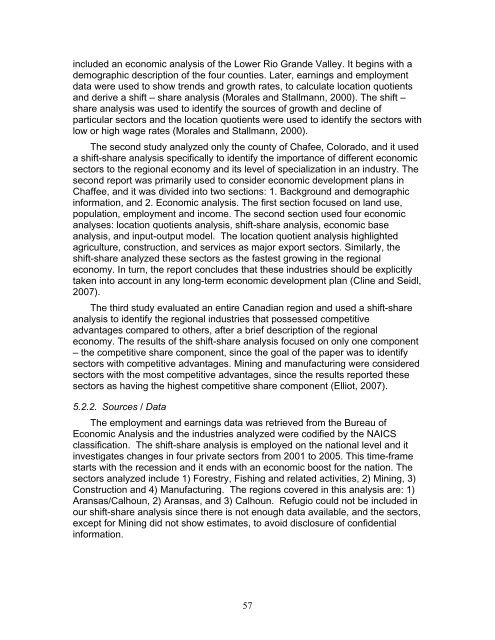The Economic Value of Water and Ecosystem Preservation
The Economic Value of Water and Ecosystem Preservation
The Economic Value of Water and Ecosystem Preservation
Create successful ePaper yourself
Turn your PDF publications into a flip-book with our unique Google optimized e-Paper software.
included an economic analysis <strong>of</strong> the Lower Rio Gr<strong>and</strong>e Valley. It begins with a<br />
demographic description <strong>of</strong> the four counties. Later, earnings <strong>and</strong> employment<br />
data were used to show trends <strong>and</strong> growth rates, to calculate location quotients<br />
<strong>and</strong> derive a shift – share analysis (Morales <strong>and</strong> Stallmann, 2000). <strong>The</strong> shift –<br />
share analysis was used to identify the sources <strong>of</strong> growth <strong>and</strong> decline <strong>of</strong><br />
particular sectors <strong>and</strong> the location quotients were used to identify the sectors with<br />
low or high wage rates (Morales <strong>and</strong> Stallmann, 2000).<br />
<strong>The</strong> second study analyzed only the county <strong>of</strong> Chafee, Colorado, <strong>and</strong> it used<br />
a shift-share analysis specifically to identify the importance <strong>of</strong> different economic<br />
sectors to the regional economy <strong>and</strong> its level <strong>of</strong> specialization in an industry. <strong>The</strong><br />
second report was primarily used to consider economic development plans in<br />
Chaffee, <strong>and</strong> it was divided into two sections: 1. Background <strong>and</strong> demographic<br />
information, <strong>and</strong> 2. <strong>Economic</strong> analysis. <strong>The</strong> first section focused on l<strong>and</strong> use,<br />
population, employment <strong>and</strong> income. <strong>The</strong> second section used four economic<br />
analyses: location quotients analysis, shift-share analysis, economic base<br />
analysis, <strong>and</strong> input-output model. <strong>The</strong> location quotient analysis highlighted<br />
agriculture, construction, <strong>and</strong> services as major export sectors. Similarly, the<br />
shift-share analyzed these sectors as the fastest growing in the regional<br />
economy. In turn, the report concludes that these industries should be explicitly<br />
taken into account in any long-term economic development plan (Cline <strong>and</strong> Seidl,<br />
2007).<br />
<strong>The</strong> third study evaluated an entire Canadian region <strong>and</strong> used a shift-share<br />
analysis to identify the regional industries that possessed competitive<br />
advantages compared to others, after a brief description <strong>of</strong> the regional<br />
economy. <strong>The</strong> results <strong>of</strong> the shift-share analysis focused on only one component<br />
– the competitive share component, since the goal <strong>of</strong> the paper was to identify<br />
sectors with competitive advantages. Mining <strong>and</strong> manufacturing were considered<br />
sectors with the most competitive advantages, since the results reported these<br />
sectors as having the highest competitive share component (Elliot, 2007).<br />
5.2.2. Sources / Data<br />
<strong>The</strong> employment <strong>and</strong> earnings data was retrieved from the Bureau <strong>of</strong><br />
<strong>Economic</strong> Analysis <strong>and</strong> the industries analyzed were codified by the NAICS<br />
classification. <strong>The</strong> shift-share analysis is employed on the national level <strong>and</strong> it<br />
investigates changes in four private sectors from 2001 to 2005. This time-frame<br />
starts with the recession <strong>and</strong> it ends with an economic boost for the nation. <strong>The</strong><br />
sectors analyzed include 1) Forestry, Fishing <strong>and</strong> related activities, 2) Mining, 3)<br />
Construction <strong>and</strong> 4) Manufacturing. <strong>The</strong> regions covered in this analysis are: 1)<br />
Aransas/Calhoun, 2) Aransas, <strong>and</strong> 3) Calhoun. Refugio could not be included in<br />
our shift-share analysis since there is not enough data available, <strong>and</strong> the sectors,<br />
except for Mining did not show estimates, to avoid disclosure <strong>of</strong> confidential<br />
information.<br />
57
















